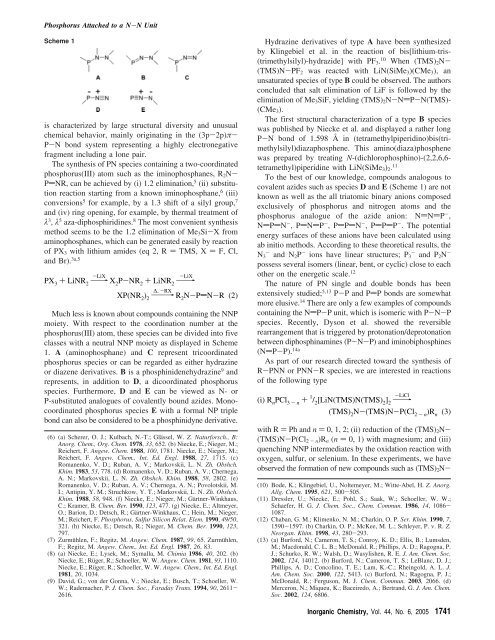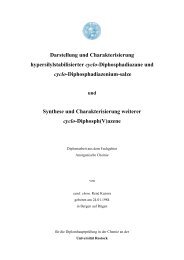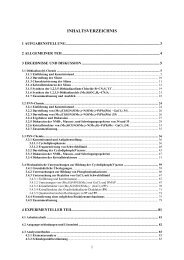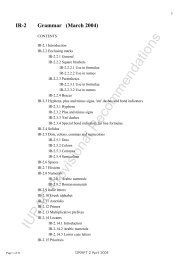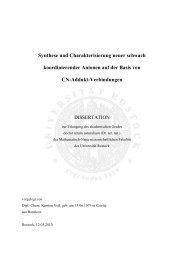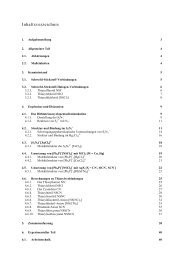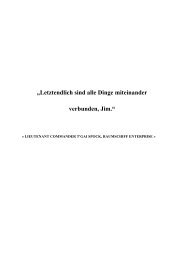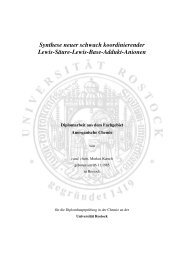Phosphorus Attached to a N-N Unit Scheme 1 is characterized by large structural diversity and unusual chemical behavior, mainly originating in the (3p-2p)π- P-N bond system representing a highly electronegative fragment including a lone pair. The synthesis of PN species containing a two-coordinated phosphorus(III) atom such as the iminophosphanes, R2N- PdNR, can be achieved by (i) 1.2 elimination, 5 (ii) substitution reaction starting from a known iminophosphane, 6 (iii) conversions 5 for example, by a 1.3 shift of a silyl group, 7 and (iv) ring opening, for example, by thermal treatment of λ 3 , λ 5 aza-diphosphiridines. 8 The most convenient synthesis method seems to be the 1.2 elimination of Me3Si-X from aminophosphanes, which can be generated easily by reaction of PX3 with lithium amides (eq 2, R ) TMS, X ) F, Cl, and Br). 3a,5 -LiX PX3 + LiNR298 -LiX X2P-NR2 + LiNR298 ∆,-RX XP(NR2 ) 298 R 2 N-PdN-R (2) Much less is known about compo<strong>und</strong>s containing the NNP moiety. With respect to the coordination number at the phosphorus(III) atom, these species can be divided into five classes with a neutral NNP moiety as displayed in Scheme 1. A (aminophosphane) and C represent tricoordinated phosphorus species or can be regarded as either hydrazine or diazene derivatives. B is a phosphinidenehydrazine 9 and represents, in addition to D, a dicoordinated phosphorus species. Furthermore, D and E can be viewed as N- or P-substituted analogues of covalently bo<strong>und</strong> azides. Monocoordinated phosphorus species E with a formal NP triple bond can also be considered to be a phosphinidyne derivative. (6) (a) Scherer, O. J.; Kulbach, N.-T.; Glässel, W. Z. Naturforsch., B: Anorg. Chem., Org. Chem. 1978, 33, 652. (b) Niecke, E.; Nieger, M.; Reichert, F. Angew. Chem. 1988, 100, 1781. Niecke, E.; Nieger, M.; Reichert, F. Angew. Chem., Int. Ed. Engl. 1988, 27, 1715. (c) Romanenko, V. D.; Ruban, A. V.; Markovskii, L. N. Zh. Obshch. Khim. 1983, 53, 778. (d) Romanenko, V. D.; Ruban, A. V.; Chernega, A. N.; Markovskii, L. N. Zh. Obshch. Khim. 1988, 58, 2802. (e) Romanenko, V. D.; Ruban, A. V.; Chernega, A. N.; Povolotskii, M. I.; Antipin, Y. M.; Struchkow, Y. T.; Markovskii, L. N. Zh. Obshch. Khim. 1988, 58, 948. (f) Niecke, E.; Nieger, M.; Gärtner-Winkhaus, C.; Kramer, B. Chem. Ber. 1990, 123, 477. (g) Niecke, E.; Altmeyer, O.; Barion, D.; Detsch, R.; Gärtner-Winkhaus, C.; Hein, M.; Nieger, M.; Reichert, F. Phosphorus, Sulfur Silicon Relat. Elem. 1990, 49/50, 321. (h) Niecke, E.; Detsch, R.; Nieger, M. Chem. Ber. 1990, 123, 797. (7) Zurmühlen, F.; Regitz, M. Angew. Chem. 1987, 99, 65. Zurmühlen, F.; Regitz, M. Angew. Chem., Int. Ed. Engl. 1987, 26, 83. (8) (a) Niecke, E.; Lysek, M.; Symalla, M. Chimia 1986, 40, 202. (b) Niecke, E.; Rüger, R.; Schoeller, W. W. Angew. Chem. 1981, 93, 1110. Niecke, E.; Rüger, R.; Schoeller, W. W. Angew. Chem., Int. Ed. Engl. 1981, 20, 1034. (9) David, G.; von der Gonna, V.; Niecke, E.; Busch, T.; Schoeller, W. W.; Rademacher, P. J. Chem. Soc., Faraday Trans. 1994, 90, 2611- 2616. Hydrazine derivatives of type A have been synthesized by Klingebiel et al. in the reaction of bis[lithium-tris- (trimethylsilyl)-hydrazide] with PF3. 10 When (TMS)2N- (TMS)N-PF2 was reacted with LiN(SiMe3)(CMe3), an unsaturated species of type B could be observed. The authors concluded that salt elimination of LiF is followed by the elimination of Me3SiF, yielding (TMS)2N-NdP-N(TMS)- (CMe3). The first structural characterization of a type B species was published by Niecke et al. and displayed a rather long P-N bond of 1.598 Å in (tetramethylpiperidino)bis(trimethylsilyl)diazaphosphene. This amino(diaza)phosphene was prepared by treating N-(dichlorophosphino)-(2,2,6,6tetramethyl)piperidine with LiN(SiMe3)2. 11 To the best of our knowledge, compo<strong>und</strong>s analogous to covalent azides such as species D and E (Scheme 1) are not known as well as the all triatomic binary anions composed exclusively of phosphorus and nitrogen atoms and the phosphorus analogue of the azide anion: NdNdP - , NdPdN - ,PdNdP - ,PdPdN - ,PdPdP - . The potential energy surfaces of these anions have been calculated using ab initio methods. According to these theoretical results, the N3 - and N2P - ions have linear structures; P3 - and P2N - possess several isomers (linear, bent, or cyclic) close to each other on the energetic scale. 12 The nature of PN single and double bonds has been extensively studied; 5,13 P-P and PdP bonds are somewhat more elusive. 14 There are only a few examples of compo<strong>und</strong>s containing the NdP-P unit, which is isomeric with P-N-P species. Recently, Dyson et al. showed the reversible rearrangement that is triggered by protonation/deprotonation between diphosphinamines (P-N-P) and iminobiphosphines (NdP-P). 14a As part of our research directed toward the synthesis of R-PNN or PNN-R species, we are interested in reactions of the following type (i) RnPCl3-n + 1 -LiCl / 2 [LiN(TMS)N(TMS) 2 ] 298 (TMS) 2N-(TMS)N-P(Cl2-n )Rn (3) with R)Ph and n)0, 1, 2; (ii) reduction of the (TMS)2N- (TMS)N-P(Cl2 - n)Rn (n ) 0, 1) with magnesium; and (iii) quenching NNP intermediates by the oxidation reaction with oxygen, sulfur, or selenium. In these experiments, we have observed the formation of new compo<strong>und</strong>s such as (TMS)2N- (10) Bode, K.; Klingebiel, U., Noltemeyer, M.; Witte-Abel, H. Z. Anorg. Allg. Chem. 1995, 621, 500-505. (11) Dressler, U.; Niecke, E.; Pohl, S.; Saak, W.; Schoeller, W. W.; Schaefer, H. G. J. Chem. Soc., Chem. Commun. 1986, 14, 1086- 1087. (12) Chaban, G. M.; Klimenko, N. M.; Charkin, O. P. Ser. Khim. 1990, 7, 1590-1597. (b) Charkin, O. P.; McKee, M. L.; Schleyer, P. v. R. Z. Neorgan. Khim. 1998, 43, 280-293. (13) (a) Burford, N.; Cameron, T. S.; Conroy, K. D.; Ellis, B.; Lumsden, M.; Macdonald, C. L. B.; McDonald, R.; Phillips, A. D.; Ragogna, P. J.; Schurko, R. W.; Walsh, D.; Wasylishen, R. E. J. Am. Chem. Soc. 2002, 124, 14012. (b) Burford, N.; Cameron, T. S.; LeBlanc, D. J.; Phillips, A. D.; Concolino, T. E.; Lam, K.-C.; Rheingold, A. L. J. Am. Chem. Soc. 2000, 122, 5413. (c) Burford, N.; Ragogna, P. J.; McDonald, R.; Ferguson, M. J. Chem. Commun. 2003, 2066. (d) Merceron, N.; Miqueu, K.; Baceiredo, A.; Bertrand, G. J. Am. Chem. Soc. 2002, 124, 6806. Inorganic Chemistry, Vol. 44, No. 6, 2005 1741
(TMS)N-P(Cl2-n)Rn (m)1, 2) together with the previously described species (TMS)NPN(TMS)2 2,3a <strong>und</strong>er modified reaction conditions. Bis[lithium-tris(trimethylsilyl)-hydrazide] seems to be a good precursor to introduce the NNP moiety via salt elimination, resulting in the formation of tetrasubstituted hydrazines. 10,15 The reaction of PCl3 with [LiN- (TMS)N(TMS)2]2 has already been described by Niecke et al., yielding (TMS)2N-(TMS)N-PCl2 (3). 16 In this paper, we report (i) our experimental results of the above-mentioned reactions of bis[lithium-tris(trimethylsilyl)hydrazide] 10,15 with RnPCl3 - n and (ii) our theoretical study of the potential energy surface of (TMS)2N-(TMS)N-PCl2 with respect to the loss of chlorosilane, resulting in the formation of TMS-NNP, (TMS)2N-NdP-Cl, and (TMS)2- NPN(TMS) species. Experimental Section General Remarks. Solvents were freshly distilled, dried, and stored <strong>und</strong>er nitrogen. NMR: JEOL Eclipse 400 and 270 ( 1 H, 13 C chemical shifts refer to δTMS ) 0.00; 31 P refers to δH3PO4(85%) ) 0.00). IR: Nicolet 520 FT-IR (as KBr pellets or in Nujol mulls between KBr windows). Raman: Perkin-Elmer spectrum 2000R NIR FT equipped with a Nd:YAG laser (1064 nm). CHN analyses: Analysator Elementar Vario EL. MS: JEOL MStation JMS 700. Melting points are uncorrected (Büchi B540). Bis[lithiumtris(trimethylsilyl)-hydrazide] was prepared according to the procedure given in the literature. 10,15 Synthesis of N,N′,N′-[Tris(trimethylsilyl)]hydrazino-(diphenyl)phosphane, (TMS)2N-(TMS)N-PPh2 (1). Into a solution of 1 g (1.95 mmol) of bis[lithium-tris(trimethylsilyl)-hydrazide] in hexane (75 mL), a solution of 0.867 g (3.9 mmol) of freshly distilled ClPPh2 in hexane (25 mL) was added during a period of 1hat ambient temperature. The white precipitate that was formed (LiCl) was separated by filtration after 2 h. The hexane was removed in vacuum, and a white waxy solid (1) was obtained, which still contained traces of LiCl. 1 was purified by sublimation (110 °C, 10 -3 mbar). (TMS)2N-(TMS)N-PPh2 (432.76) yield: 1.65 g (98%) colorless crystals, mp 108 °C. IR (KBr, cm -1 ): ν˜ 3075 w, 3047 w, 2974 m, 2952 m, 2896 m, 1585 w, 1520 w, 1436 m, 1430 m, 1404 w, 1310 w, 1264 s, 1248 vs, 1242 s, 1179 m, 1104 m, 1085 w, 1067 w, 1030 m, 1014 s, 910 vs, 879 vs, 854 vs, 835 vs, 817 vs, 774 s, 740 s, 705 m, 695 s, 672 s, 618 m, 607 m, 512 m, 487 m, 465 m, 419 w, 385 s, 372 m. Raman (200mW, 25 °C, cm -1 ): ν˜ 3172 (0.5), 3138 (0.5), 3055 (9), 2977 (5), 2954 (6), 2899 (10), 1588 (9), 1573 (3), 1410 (2, br), 1180 (2), 1157 (2), 1103 (3), 1089 (3), 1030 (4), 1002 (10), 678 (3), 643 (5), 619 (3), 467 (2), 420 (14) (a) Fei, Z.; Biricik, N.; Zhao, D.; Scopelliti, R.; Dyson, P. J. Inorg. Chem. 2004, 43, 2228-2230. (b)Yoshifuji, M.; Shima, I.; Inamoto, N.; Hirotsu, K.; Higuchi, T. J. Am. Chem. Soc. 1981, 103, 4587. (c) Yoshifuji, M.; Shibayama, K.; Inamoto, N.; Matsushita, T.; Nishimoto, K. J. Am. Chem. Soc. 1983, 105, 2495. (d) Kaukorat, T.; Neda, I.; Schmutzler, R. Coord. Chem. ReV. 1994, 137, 53. (e) Burford, N.; Cameron, T. S.; LeBlanc, D. J.; Losier, P.; Sereda, S.; Wu, G. Organometallics 1997, 16, 4712. (f) Kato, T.; Gornitzka, H.; Baceiredo, A.; Schoeller, W. W.; Bertrand, G. Science 2000, 289, 754. (g) Kato, T.; Gornitzka, H.; Baceiredo, A.; Schoeller, W. W.; Bertrand, G. J. Am. Chem. Soc. 2002, 124, 2506. (15) (a) K. Seppelt, W. S<strong>und</strong>ermeyer, Chem. Ber. 1969, 102, 1247-1252. (b) Metzler, N.; Nöth, H.; Sachdev, H. Angew. Chem. 1994, 106, 1837-1839. Metzler, N.; Nöth, H.; Sachdev, H. Angew. Chem., Int. Ed. Engl. 1994, 17, 1746-1748. (16) Niecke, E.; Altmeyer, O.; Nieger, M.; Knoll, F. Angew. Chem. 1987, 99, 1299-1300. Niecke, E.; Altmeyer, O.; Nieger, M.; Knoll, F. Angew. Chem., Int. Ed. Engl. 1987, 26, 1257. 1742 Inorganic Chemistry, Vol. 44, No. 6, 2005 Fischer et al. (3), 404 (3), 388 (1), 332 (1), 261 (4), 210 (4). 1 H NMR (CDCl3, 25 °C): δ 0.08 (s, 18 H, TMS), 0.10 (s, 9 H, TMS), 7.32 (m, 4 H, Ph), 7.61 (m, 6 H, Ph). 13 C NMR (CDCl3, 25°C): δ 4.04 (s, N(Si- (CH3)3)2), 4.07 (s, NSi(CH3)3), 127.94 (d, 3 JCP ) 6.2 Hz, Cphenyl), 128.99 (s, br Cphenyl), 134.5 (d, 2 JCP ) 22.8 Hz, Cphenyl), 140.08 (d, 1 JCP ) 20.8 Hz, Cphenyl). 31 P NMR (CDCl3, 25°C): δ 61.4 (s). 29 Si{ 1 H} NMR (CDCl3, 270 MHz, 25 °C): δ 8.93 (d, 3 JSiP ) 1.3 Hz, N(Si(CH3)3)2), 13.42 (d, 2 JSiP ) 7.9 Hz, NSi(CH3)3). MS (EI, 70 eV, >5%) m/z (%): 432 (3) [M + ], 417 (10) [M + - CH3], 332 (6), 331 (20), 321 (8) [(TMS)2NN(TMS)2 + ], 320 (23) [((TMS)2- NN(TMS)2 - H) + ], 305 (7) [((TMS)2NN(TMS)2 - CH3) + ], 273 (8) [(TMS)HN-PPh2 + ], 272 (30) [(TMS)N-PPh2 + ], 248 (5) [(TMS)2N-NH(TMS) + ], 247 (14) [(TMS)2N-N(TMS) + ], 232 (7), 231 (15), 218 (8), 217 (28), 204 (9), 197 (7), 175 (6), 174 (30), 146 (12) [TMS-TMS + ], 135 (15), 131 (7), 130 (22), 74 (9) [HSi- (CH3)3 + ], 73 (100) [SiCH3)3 + ], 45 (5). C21H37N2P1Si3 (432.76): calcd C 58.28, H 8.62, N 6.47; fo<strong>und</strong> C 58.63, H 8.44, N 6.02. HR-MS: C21H37N2P1Si3 (432.76) requires M + ) 432.2002; fo<strong>und</strong> 432.2002. Synthesis of N,N′,N′-[Tris(trimethylsilyl)]hydrazino-phenyl- (chloro)phosphane, (TMS)2N-(TMS)N-P(Cl)Ph (2). Into a solution of 1 g (1.95 mmol) of bis[lithium-tris(trimethylsilyl)hydrazide] in hexane (75 mL), a solution of 0.703 g (3.9 mmol) of freshly distilled Cl2PPh in hexane (25 mL) was added during a period of 1hatambient temperature. The white precipitate that was formed (LiCl) was separated by filtration after 2 h. The hexane was removed in vacuum, and a waxy solid (2) was obtained, which still contained traces of LiCl. 2 was purified by sublimation (110 °C, 10 -3 mbar). (TMS)2N-(TMS)N-P(Cl)Ph (391.11) yield: 1.45 g (95%) colorless crystals, mp 118 °C. IR (KBr, cm -1 ): ν˜ 3059 m, 3057 m, 2955 s, 2900 m, 1586 w, 1479 m, 1434 s, 1405 m, 1307 w, 1251 vs, 1249 vs, 1182 w, 1156 w, 1089 s, 1013 s, 913 br vs, 881 vs, 836 vs, 769 s, 742 vs, 699 vs, 661 s, 619 m, 607 m, 581 m, 500 br m, 465 m, 438 w, 417 w, 387 m. Raman (300 mW, 25 °C, cm -1 ): ν˜ 3172 (0.5), 3144 (0.5), 3067 (7), 3048 (3), 2956 (5), 2903 (10), 1587 (4), 1574 (1), 1411 (2), 1183 (1), 1159 (1), 1089 (1), 1029 (3), 1003 (5), 689 (2), 666 (2), 648 (6), 620 (1), 499 (1), 448 (3), 413 (1), 372 (4), 346 (1), 272 (5), 197 (3, br). 1 H NMR (CDCl3,25°C): δ 0.01 (s, 9 H, TMS), 0.27 (s, 18 H, TMS), 7.42 (m, 2 H, Ph), 7.95 (m, 3 H, Ph). 13 C NMR (CDCl3, 25°C): δ 3.05 (s, NSi(CH3)3)2), 3.09 (s, NSi(CH3)3), 128.1 (d, 3 JCP ) 6.1 Hz, Cphenyl), 130.6 (s, Cphenyl), 132.6 (d, 2 JCP ) 26.1 Hz, Cphenyl), 138.20 (d, 1 JCP ) 38.4 Hz, Cphenyl). 31 P NMR (CDCl3, 25°C): δ 145.2 (s). 29 Si{ 1 H} NMR (CDCl3,25°C): δ 11.3 (s, N(Si(CH3)3)2), 19.1 (d, 2 JSiP ) 2.0 Hz, NSi(CH3)3). MS (EI, 70 eV, >5%) m/z (%): 390 (3) [M + ], 375 (6) [M + - CH3], 289 (5), 248 (8) [(TMS)2N-NH(TMS) + ], 247 (32) [(TMS)2N-N(TMS) + ], 174 (25), 146 (12) [TMS-TMS + ], 135 (9), 131 (7), 130 (12), 74 (9) [HSi- (CH3)3 + ], 73 (100) [SiCH3)3 + ], 45 (6), 36 (7). C15H32Cl1N2P1Si3 (391.11): calcd C 46.07, H 8.25, N 7.16; fo<strong>und</strong> C 46.47, H 8.66, N 7.36. Synthesis of N,N′,N′-[Tris(trimethylsilyl)]hydrazino-(dichloro)phosphane, (TMS)2N-(TMS)N-PCl2 (3). 3 was prepared according to the procedure given in the literature. 16 3 can be purified further by sublimation (65 °C, 10 -3 mbar). (TMS)2N-(TMS)N- PCl2 (349.46) yield: 90% colorless ceraceous crystals, mp 114 °C (slow dec). Raman (200mW, 25 °C, cm -1 ): ν˜ 2960 (5), 2904 (10), 1411 (2), 687 (2), 658 (2), 645 (7), 585 (1.5), 466 (4), 448 (4), 438 (4), 364 (4), 351 (4), 232 (4, br), 188 (4, br), 144 (2, br). 1 H NMR (CDCl3, 25°C): δ 0.19 (s, 18 H, TMS), 0.38 (s, 9 H, TMS). 13 C NMR (CDCl3,25°C): δ 2.46 (s, NSi(CH3)3)2), 2.51 (s, NSi(CH3)3). 31 P NMR (CDCl3, 25°C): δ 166.6 (s). 29 Si{ 1 H} NMR (CDCl3, 25
- Page 1 and 2: Darstellung und Charakterisierung n
- Page 3 and 4: Erklärung Ich versichere hiermit a
- Page 5 and 6: Der gesamten Arbeitsgruppe möchte
- Page 7 and 8: Inhaltsverzeichnis 1. Aufgabenstell
- Page 9 and 10: 1. Aufgabenstellung Ausgangspunkt d
- Page 11 and 12: 2. Allgemeiner Teil 2.1. Abkürzung
- Page 13 and 14: durch eine große strukturelle Viel
- Page 15 and 16: Abbildung 5. Synthese N,N-Bis(trime
- Page 17 and 18: 3.4 Binäre viergliedrige Phosphor(
- Page 19 and 20: 4. Ergebnisse und Diskussion 4.1 Ei
- Page 21 and 22: Strukturmerkmale formulieren: (i) M
- Page 23 and 24: synthetisiert werden, weshalb sie s
- Page 25 and 26: Abbildung 14. Molekülstruktur des
- Page 27 and 28: werden, allerdings liegt das Iminoc
- Page 29 and 30: 4.5. Eine ungewöhnliche Reaktion:
- Page 31 and 32: 4.6. Lewis-Säure-assistierte Methy
- Page 33 and 34: Die durchgeführten Austauschreakti
- Page 35 and 36: Um das Dimer/Monomer-Gleichgewicht
- Page 37 and 38: Bei Zugabe von nur einem Äquivalen
- Page 39 and 40: 5. Ausgewählte Original-Publikatio
- Page 41: Mono-, Di-, and Tricoordinated Phos
- Page 45 and 46: molecules are rather constant and r
- Page 47 and 48: Figure 1. Calculated molecular stru
- Page 49 and 50: Figure 6. PES for the rearrangement
- Page 51 and 52: Figure 12. PES of the intrinsic TMS
- Page 53 and 54: 5.2 Ein Triazadiphosphol Sebastian
- Page 55 and 56: Schema 1. Synthese der GaCl 3-Adduk
- Page 57 and 58: Die ausschließliche Bildung von 2
- Page 59 and 60: COMMUNICATION www.rsc.org/chemcomm
- Page 61 and 62: [Mes* 2 2 t Bu 2 2H] + , 56 (16.4)
- Page 63 and 64: P/N-Kationen Ein kationisches cycli
- Page 65 and 66: gruppe C2/c mit vier Einheiten in d
- Page 67 and 68: 5.5. An Unusual Reaction: a GaCl3-A
- Page 69 and 70: GaCl3-Assisted Methyl/Chlorine Exch
- Page 71 and 72: GaCl3-Assisted Methyl/Chlorine Exch
- Page 73 and 74: GaCl3-Assisted Methyl/Chlorine Exch
- Page 75 and 76: 5.6. Lewis-Acid-Assisted Methyl Exc
- Page 77 and 78: Obviously, in case of the arsenic c
- Page 79 and 80: It is interesting to note that in t
- Page 81 and 82: Table 1. Selected bond lengths (in
- Page 83 and 84: (8.35). 29 Si NMR (59.6 MHz, CD 2 C
- Page 85 and 86: (1) a) Huisgen, R. in 1,3-Dipolar C
- Page 87 and 88: Zuschriften Arsen-Stickstoff-Verbin
- Page 89 and 90: Zuschriften liumatom eine von + 1.4
- Page 91 and 92: 5.8 Cationic Cyclic Arsenic(III)Azi
- Page 93 and 94:
exchange occurs in the cation (reac
- Page 95 and 96:
H. Nöth, R. Ullmann, Chem. Ber. 19
- Page 97 and 98:
[27] a) A. Hahma, E. Holmberg, N. H
- Page 99 and 100:
Publikationen 30. Mono-, Di-, and T
- Page 101 and 102:
Markus Kowalewski, Burkart Krumm, P
- Page 103 and 104:
Z. Anorg. Allg. Chem. 2008, eingere
- Page 105 and 106:
Tetrahedron Lett. 2008, 49, 4901 -
- Page 107 and 108:
Münchner Industrie-Tag, Oktober 20
- Page 109:
Berufstätigkeit 09/2000 - 11/2000


